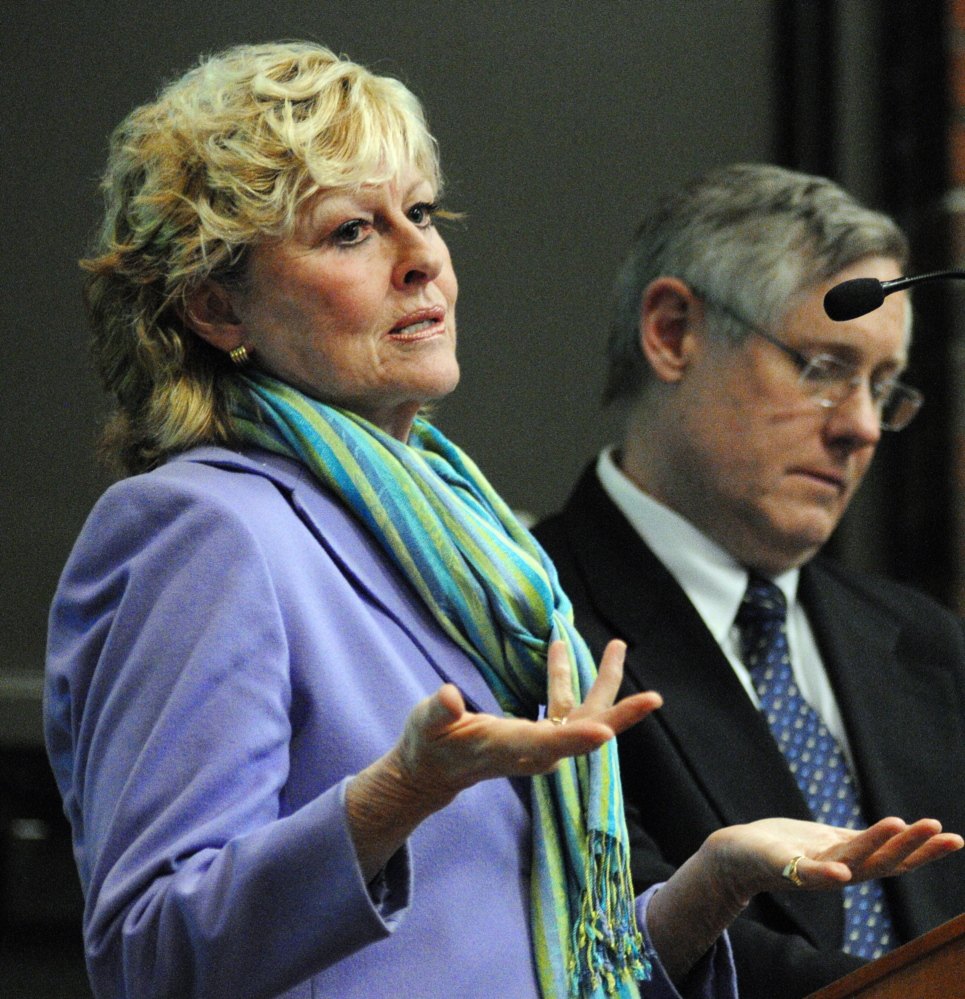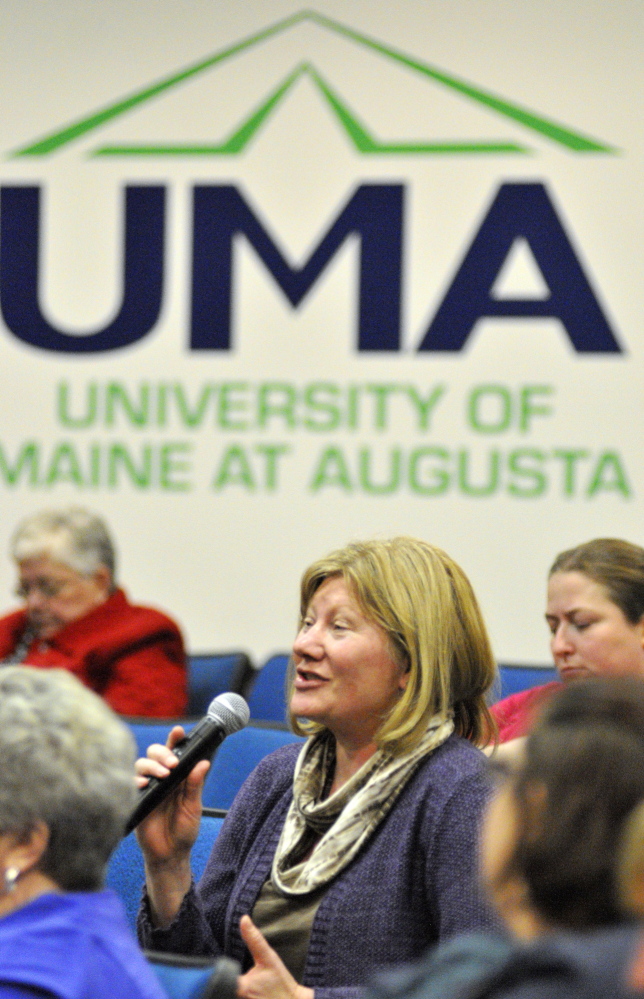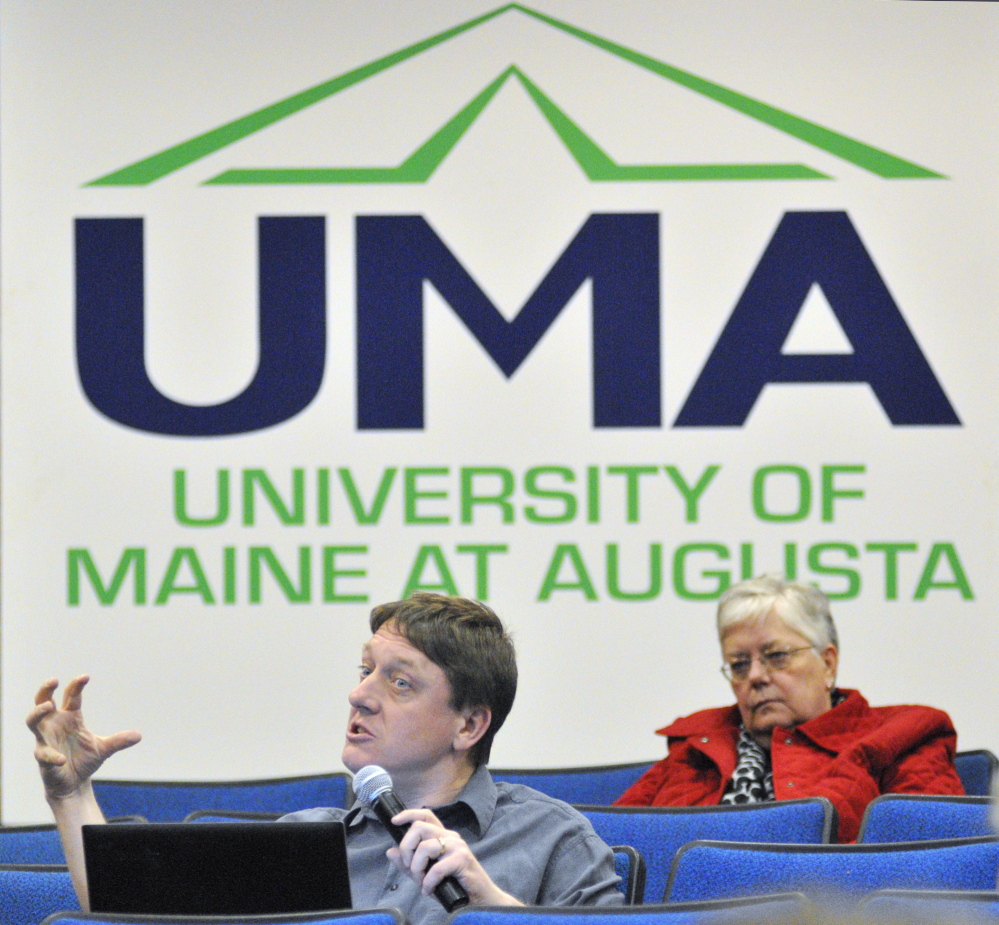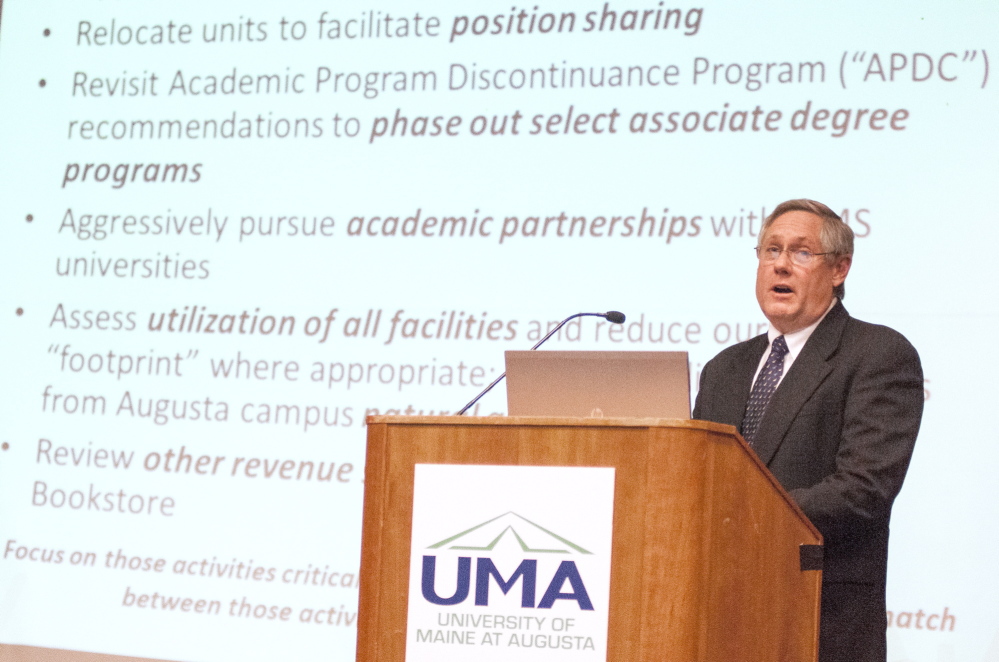AUGUSTA — Audience members at a University of Maine at Augusta budget presentation Wednesday seemed mostly accepting of the proposed $2.7 million in cuts but also raised questions about the impact on students.
The university’s 2014-15 budget eliminates 24 faculty and staff jobs, 10 of which are occupied, and reduces the hours or work year for 33 jobs. UMA also will cut back spending on athletics, food service on the Augusta campus and leased instructional space in the Midcoast and Saco.
UMA also announced plans to phase out associate degree programs in nursing and veterinary technology, though that won’t show up in budgets for about three years.
About 45 people attended the presentation in Jewett Hall by President Allyson Handley and Vice President for Finance and Administration Tim Brokaw, while others watched a webstream from the Bangor campus and elsewhere.
The most pointed questions were related to the decision to close much of the Bangor campus during the second summer session in July and August, including the library, student services and all face-to-face classes. People in the audience said they are concerned about the effects on students who depend on income from summer work-study jobs, distance-education classes that meet on campus and recruiting efforts, given the prospect of students touring an empty campus.
Handley said the university is still working out details to ensure the transition will be seamless for students and may add more online or distance classes to make up for the face-to-face classes cut.
People in the audience asked about the prospects for students in academic programs that will be phased out in the next three to four years, particularly the associate degree in nursing.
Handley said all students currently enrolled in the programs or on the waiting list for nursing will have the opportunity to earn the degree at UMA. The university also is working on an agreement with the University of Maine at Fort Kent that would allow students to take the first year of a bachelor’s degree in nursing at UMA, then finish the degree at UMFK.
In addition, UMA will continue to offer a bachelor’s completion program for registered nurses who enroll.
Hirosuke Honda, a research analyst in the office of Institutional Research and Planning, asked Handley whether UMA is at the end, middle or entrance of a tunnel regarding its long-term sustainability.
Handley said she believes the University of Maine System is in the middle, but the state has not even reached that point yet because it’s difficult to make changes at that scale to complete the recovery from the recession. She expressed optimism about UMA’s position.
“While we’ve been cutting over the six years that I’ve been here, we’ve continued to invest, and to me that is the sign of an institution that is resilient,” she said. “The reality is right now, with the perfect storm, we’re trying to build the airplane as we’re flying it.”
Handley cited two programs that started in the fall, the bachelor of science in aviation and the five-year bachelor of architecture, as two areas where UMA has made new investments to meet workforce needs with programs that are unique in Maine or New England.
After the meeting, Honda said what he’s learned in his studies of higher education policy back up Handley’s statements about creativity and resilience.
“Financially stable institutions are status quo,” he said. “Compared to that, UMA has potential.”
All seven institutions in the university system and the central office are making cuts to close a $36 million systemwide budget gap for next year.
UMA came up with $2.7 million in reductions, though Brokaw warned that number may have to go higher if the Legislature reduces the university system’s appropriation to deal with a deficit in the state budget.
UMA’s resulting $36 million budget is the university’s smallest since a $34 million budget in 2010-11.
Brokaw said that because of more costly health insurance premiums and raises given to employees in new labor contracts, personnel costs would have risen by nearly $2 million if all employees stayed on.
Administrators found about $1.7 million in savings from pay and benefits by cutting 24 jobs, reducing hours for 33 others and eliminating 40 course sections taught by adjunct instructors.
Among the jobs being cut, 10 are occupied, while the other 14 are vacant. Ten are faculty jobs. The 24 jobs are the equivalent of 19.2 full-time positions, about 5 percent of UMA’s total full-time equivalent employment of 379.
Since UMA’s employment peaked in 2008 at 410 full-time equivalent positions, budget cuts have hit the categories of administrators and hourly employees hardest, with reductions of 19 percent and 17 percent, respectively.
UMA also is suffering from declining enrollment. The university exceeded enrollment projections for years but has fallen short of the projections in this year’s budget by 2.5 percent in the fall and 3.8 percent in the spring, although enrollment was above budget by 2 percent for summer. Overall, enrollment is down 4.8 percent from last year.
At the peak in 2012-13, UMA students took about 96,000 credit hours, but that number has fallen below 92,000. Because tuition has been frozen since 2011-12, fewer classes taken means less tuition revenue.
The planned elimination of the associate degree programs in nursing and veterinary technology is part of UMA’s ongoing shift toward providing more bachelor’s degrees. Handley said more employers are also looking for nurses with bachelor’s degrees.
The two programs being phased out are also among the most expensive for UMA in net cost. The two-year degree in nursing loses about $1.5 million for the university annually, while the veterinary technology program loses more than $200,000.
The only program that is more expensive than veterinary technology, other than the associate in nursing, is the dental health program, which offers bachelor’s and associate degrees in dental hygiene and an associate degree and a certificate in dental assisting.
Dental health runs about $900,000 in the red, but Handley said UMA maintains it because it meets a workforce need and provides a public service through its low-cost dental health clinic.
James Cook, assistant professor of social science, said after the presentation that he appreciates that UMA’s leaders are facing difficult decisions.
“They’re doing the best they can in a difficult situation,” he said. “We’re all looking out for students’ situations the best we can.”
Susan McMillan — 621-5645smcmillan@centralmaine.comTwitter: @s_e_mcmillan
Send questions/comments to the editors.






Success. Please wait for the page to reload. If the page does not reload within 5 seconds, please refresh the page.
Enter your email and password to access comments.
Hi, to comment on stories you must . This profile is in addition to your subscription and website login.
Already have a commenting profile? .
Invalid username/password.
Please check your email to confirm and complete your registration.
Only subscribers are eligible to post comments. Please subscribe or login first for digital access. Here’s why.
Use the form below to reset your password. When you've submitted your account email, we will send an email with a reset code.